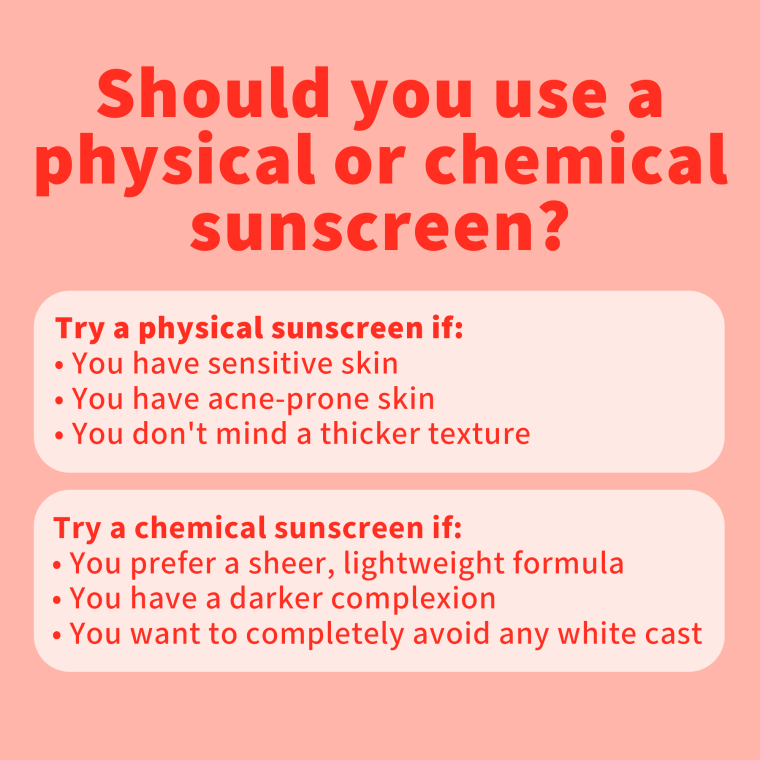No matter what type of skin you have or what skin issues you want to address, experts agree that sunscreen should be an essential step in your skin-care routine every single day.
Unfortunately, many people think of sunscreen as a thick, streaky, hard-to-apply product that too often leaves a noticeable white cast. Other folks are bombarded with dubious claims on social media that sunscreen is harmful — or even cancer-causing.
The truth is that sunscreen prevents sunburn and the UV damage that raises your risk for skin cancer — including both melanoma and non-melanoma skin cancers, Dr. Abigail Waldman, clinical director of the Mohs and Dermatologic Surgery Center and Brigham and Women’s Hospital and assistant professor at Harvard Medical School, told TODAY.com recently.
Sunscreen also helps prevent UV-related cosmetic changes to the skin, including premature signs of aging like fine lines, sagging skin and sun spots. Protecting your skin from UV exposure aids in managing many common skin conditions, including rosacea and melanoma.
That means finding a sunscreen that you actually enjoy using on a daily basis can have major impact on your overall skin health. And these days you have a ton of SPF options to choose from.
Here’s how to pick the one that’s right for your skin type and preferences, according to dermatologists.
How to choose the best sunscreen
While there a lot of sunscreens to choose from, experts tell TODAY.com that there are also some non-negotiables when it comes to picking an SPF product.
Any sunscreen you buy should:
- Contain at least SPF 30
- Provide broad-spectrum protection, meaning it protects against both UVA and UVB rays
- Feel and look nice enough that you don’t mind applying every day
- Not be past its expiration date
From there, you can make personal decisions regarding which type of formulation works better for you.
Chemical sunscreen vs. mineral sunscreen
The primary difference between chemical sunscreens and mineral sunscreens is how each protects your skin.
Chemical sunscreen ingredients — such as avobenzone, octocrylene and oxybenzone — absorb UV light rather than blocking it. The UV rays are then converted into a non-damaging form of heat. Imagine these as little baseball mitts that capture UV rays and convert them into a harmless form of heat, board-certified dermatologist Dr. Ellen Marmur, tells TODAY.com.
Mineral sunscreens, also sometimes called physical sunscreens., work a little differently. In addition to absorbing some UV rays, physical sunscreens “create a barrier on top of the skin that shields the sun’s rays,” says Marmur, who is also the founder of Skin Cancer, Take a Hike!, an initiative to raise funds for skin cancer prevention.
These differences in ingredients can also affect the formulation, meaning the way the product feels and acts on your skin.
Mineral sunscreens, which are made with zinc oxide and titanium dioxide, tend to feel slightly thicker and may leave an opaque white cast on the skin. Tinted sunscreens, often made with protective iron oxides, can counteract some of this effect.
Chemical sunscreens, however, tend to be more sheer and light on the skin. “Don’t let fears about chemicals outweigh the fear or risk of the UV rays, which remains the major risk factor for skin cancer,” board-certified dermatologist Dr. Ava Shamban tells TODAY.com.
Generally, the experts recommend people with sensitive skin or certain skin issues — eczema, rosacea, psoriasis, for instance — opt for mineral sunscreens over chemical sunscreens.
But some people find that mineral sunscreens are more challenging to remove at the end of the day, Dr. Helen He, practicing dermatologist and assistant professor of dermatology at the Icahn School of Medicine at Mount Sinai, told TODAY.com recently.
That means mineral sunscreens might require more rubbing and scrubbing to get them off, which could exacerbate sensitive skin issues, she says.

Try a physical sunscreen if:
- You have sensitive skin, including sensitizing skin conditions such as rosacea, psoriasis and eczema
- You have acne-prone skin
You may prefer a chemical sunscreen if:
- You prefer a sheer and lightweight formulation
- You have a darker complexion
- You want to avoid a white cast
- You find mineral sunscreens hard to remove
There are also hybrid sunscreens, the American Academy of Dermatology explains, which are made with a combination of physical and chemical SPF ingredients. These sunscreens tend to fall somewhere in the middle of the pack, providing the gentle protection of mineral sunscreens in easier-to-blend formulas.
However, they still may feel thicker than purely chemical sunscreens, even small amounts of chemical sunscreen ingredients can be irritating to sensitive skin and they can still have a cast.
What SPF value should you look for?
The next element to consider when choosing a sunscreen is the SPF, which stands for sun protective factor.
When it comes to SPF, “The higher your number, the more protection you have, the less of the chance of a sunburn,” Dr. Marnie Nussbaum, a board-certified dermatologist, told The TODAY Show during a segment on June 20, 2023.
The AAD recommends wearing a broad-spectrum sunscreen with an SPF of 30 or higher every day. This protects against approximately 97% of the sun’s UV rays.
You can also opt for a higher SPF, but no sunscreen blocks 100% of the sun’s rays, the AAD explains. It’s more important to choose sunscreens with higher SPFs if you’re spending more time in direct sunlight, Marmur notes.
No matter what sunscreen you choose, you’ll still need to reapply it with the same consistency: every two hours outdoors (or after getting wet) and every four hours indoors.
Best sunscreen formulations
Sunscreen comes in many forms, including cream, gel, spray, sticks, lotion, serum and powder.
In general, you should use whichever one you’re most likely to keep up with. “The best sunscreen is the one you’re going to use because consistency is key,” Nussbaum said.
But, as experts told TODAY.com previously, not all of these formats are equally protective. A spray can provide patchy coverage, for example, and still needs to be rubbed into the skin. And a sunscreen stick, while convenient, needs to be passed over the skin multiple times before there’s enough product to provide the advertised SPF protection, the experts said.
Still, any sunscreen is better than none. And if you’re hiking or at the beach, you may be far more likely to reapply your SPF in a more convenient format, like a spray, than you would with a cream.
“I suggest having a plethora of all of the types of sun protection and select what is best for your life each day,” Marmur recommends. “For instance, a spray at the beach, a lotion at the pool and a stick for your kids and your eyes, lips, nose. A powder for reapplication during the day over your makeup is also good to keep on hand.”
Just keep in mind that each sunscreen type requires a unique application approach. Follow the label instructions to make sure you’re getting the SPF protection that’s advertised on the label.
Don’t rely on makeup with built-in SPF
You can buy tons of makeup products that contain SPF, but you still need to use actual sunscreen along with these products.
“Most makeup and moisturizers with sunscreen often do not have enough protection,” Shamban warns. Additionally, even if the makeup advertises SPF 30, people generally don’t use enough of the product or don’t use it over enough of their skin for it to function as sunscreen.
So, if you’re using SPF makeup, you should layer it over a separate sunscreen. Or, if you prefer to use just one light protective layer, “A tinted sunscreen product is usually a better option,” Shamban explains.
Other considerations when choosing a sunscreen
Certain lifestyle and other factors might also come into play when choosing the best sunscreen for you.
- Sensitive or acne-prone skin: Choose a physical SPF that’s free of dyes and fragrances, which are common irritants. Products labeled as non-comedogenic are most suitable for acne-prone skin and won’t clog pores.
- Playing sports: Sweat can make your sunscreen less effective. Look for a “sport” or sweat-proof sunscreen, which is likely to provide protection for longer.
- Spending time outdoors: If you’re going to spend a lot of time outdoors, opt for a higher SPF. Remember that SPF 30 is just a minimum.
- Makeup and reapplication: Sunscreen should be reapplied every two to four hours, or after sweating or getting wet. If you wear makeup, choose sunscreen that’s easy to reapply, such as a pressed powder or lightweight moisturizing sunscreen.
Ultimately, the best sunscreen for you is one that meets the non-negotiable criteria — and that you actually enjoy using every single day. After all, when a product is simple to apply, it’s much easier to make into a habit.
Read the full article here



:focal(1347x419:1349x417)/origin-imgresizer.eurosport.com/2024/11/24/4065325-82444148-2560-1440.jpg)












